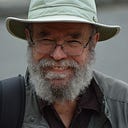The Joys of Others
Instructed to reflect on the joys of others, Phil sought signs of gladness. First he just looked for any smile. When he saw one, he would reach and touch that person’s aura.
Not everyone felt happiness. He discovered that many people who smiled did not have joy in them. He found a woman serving coffee who had a kind warm face, but in her was desperation and fear.
Joy was surprisingly similar from person to person: a kind of rising, opening pleasure, fearless and delighted.
He found people who fed joy back into themselves, so they became self-resonating in their gladness. He felt a pleasure in being near them that had no exterior agenda. A young black woman was such, waiting for a bus bright in her red cape over a white suit. He wanted to be near her, and he saw others seek the opportunity to speak with her.
These luminaries were rare. More common were those who were conditionally, and thus momentarily, happy.
A woman with a strange gaunt face got on his train with her lover who was stolid and lumpy. Her heart exulted that she was with someone who found her wonderful. Much of the time she hid her pleasure, successfully; but from time to time delight came up through her middle and made her features suddenly beautiful.
Phil saw a man happy because he was in control at that instant. Phil could see only the man, and could not see who he was with. It was clear from the man’s affect that he was for the moment in charge in this relationship: he had that sort of glossy, successful laugh. Phil had never noticed how transient and vulnerable happiness based on power was, and he did not care for it. He could sense that it was nonetheless real.
Sometimes, when he was very quiet, Phil could feel the cells of the bodies themselves being happy. He did not know why — it was like being a guest at a wedding where you do not speak the language — but it seemed it was simply *being* that provoked the happiness.
He was surprised and enriched by the instructions. His practice of looking for, then feeling, the joy of others made his own dourness soften and melt. At first he had been moved by the happiness of other people, infected with their pleasure. Now he became a center of this same contagion. He smiled for no reason. Others smiled as they saw his gladness. His world became (by this practice) more joy-full.
Only after he had followed these instructions for some time did he wonder where they had come from. The practice had appeared, floating in his mind. But who had brought it? He had a dim sense that there had been someone. Each time he tried to draw “the bringers” into his memory, like deliverymen in anonymous uniforms they disappeared. He sat in the dawning pleasure and realized he did not know whom to thank.
— — — — — —
The Image is from 868153-pxhere.com.
Birrell Walsh PhD is the author of the nonfiction Praying for Others (Crossroad, 2003), and of four Catholic Tantra novels beginning with Sister Clare’s Lover (2009) and Illuminating Four Cities (2010) . His works can be found at http://btwreviews.com. He moderates an international online Buddhist list.
